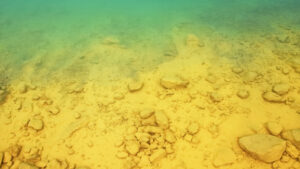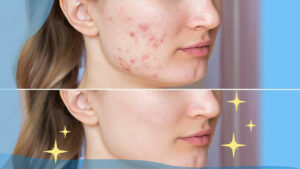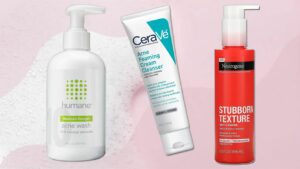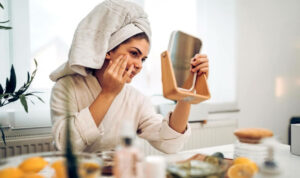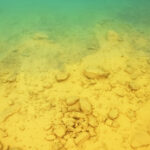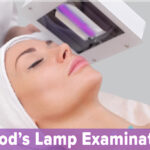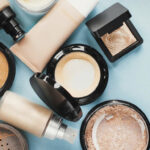Wood’s Lamp Examination in Detecting Fungal Acne & Other Skin Diseases

Did you know that, aside from basic tests like potassium hydroxide, there are other ways to detect bacterial or fungal skin disorders? Well, now you know.
A Wood’s lamp skin examination is another common approach. It is a simple and non-invasive procedure that any medical professional can perform at their place of practice.
You may have heard about this method from a lot of people, but still, you should know how it works. So, let us find out more about this approach.
What is a Wood’s Lamp?
A wood’s lamp is a type of ultraviolet light discovered by Robert Wood. The light helps to detect the presence of fungus and bacteria on the skin. It is a common tool used by dermatologists to diagnose fungal or bacterial skin conditions.
How does a Wood Lamp Examination Work?
Wood’s lamp emits long-wave ultraviolet light in the short-wave range. This light therapy helps detect compounds and the presence of fungi and bacteria on the skin. The light will cause these organisms to fluoresce or glow.
A wood lamp skin examination is non-invasive and risk-free. It entails the following procedures:
- Your skin should be adequately cleansed but not recently washed.
- Your healthcare provider will switch on the Wood’s lamp for about a minute to warm it up.
- Then they’ll switch off the lights in the room and close any drapes to darken it completely.
- Your healthcare practitioner will check your skin or hair (hair follicles) for seconds while holding the Wood’s lamp several inches away.
The doctor will ask you to remove any clothing or jewelry that may block the light during the examination. They will then turn off the lights in the room and place the Wood’s lamp close to your skin.
The light that shines from the lamp will cause the fungus to glow. The doctor will then be able to see the fungus and make a diagnosis.
It is important to note that normal or healthy skin will not illuminate under the Wood’s lamps. It will only maintain a dull blue color under the light. However, bacterial and other infections emit light with a longer wavelength than electromagnetic radiation for fungal infections.
This can be referred to as Fluorescence. Skins with pigment disorders appear purple or violet when the lamp is placed over the affected areas.
How to Prepare for the Test (Fungal & Bacterial infections)
You do not need to do anything special to prepare for this diagnostic test. Just follow these simple instructions:
- Do not scrub or shave the area to be examined
- Do not use deodorant, cosmetics, perfumes, or lotions on the area to be examined, as this may result in a false positive reading.
- If you usually wear contact lenses, it would be best to remove them
- Wear loose, comfortable clothing that does not restrict movement
What does a Wood’s Lamp Exam Show?
A Wood’s lamp exam can help detect the following:
Tinea Versicolor (a fungal infection that results in patches of skin that are lighter or darker than the surrounding skin).
Pityriasis Versicolor (a long-term fungal infection that results in scaly, white patches on the skin).
Ringworm (a skin condition that appears as a red, itchy pigmented rash on the skin).
Candidiasis (a skin disorder that causes white patches on the skin.
Pityrosporum Folliculitis: (an itchy fungal skin infection that mimics acne).
Safety Concerns
Wood’s lamp emits ultraviolet bright blue-white light. Ultraviolet light is a type of electromagnetic spectrum radiation. It is the same kind of light that is used in tanning beds. Ultraviolet light can be harmful to the skin and eyes.
For this reason, it is important to wear protective clothing, such as gloves and goggles, when using these lamps.
Pregnant women should not use a Wood’s lamp, as the ultraviolet bright blue-white light can harm the developing baby. Before buying any Wood’s lamp it’s best to perform a quick ultraviolet black light test.
It is also essential to be careful when using ultraviolet light on children. Always ensure they do not look directly into the light. If you have further concerns about the safety of these lamps, you can always talk to your healthcare provider and have the results medically reviewed.
Benefits of Wood’s Lamp Examination
A Wood’s lamp examination is an affordable and painless procedure. It is also a quick way to determine whether your acne is caused by bacteria or fungus. Here are some benefits of a wood’s light exam:
Bacterial infections: A Wood’s light examination is both non-invasive and risk-free. Under Wood’s light, bacterial illnesses, particularly pseudomonal diseases, appear light green.
Malassezia Folliculitis (Fungal acne): It’s difficult to detect a yeast infection that affects your hair follicles.
It’s tough to see as it looks a lot like regular acne but is simpler to detect through an ultraviolet light test. Under a Wood’s lamp, this type of fungal skin infection appears yellowish green. Additionally, this skin disease can be seen on the upper half of the back and chest, as well as the arms and face.
Vitiligo: Vitiligo will have distinct boundaries and appear bright blue-white or yellow-green under a Wood’s lamp. Vitiligo is a skin condition in which melanin-producing cells are destroyed, causing the infected skin to become discolored forming spots or patches, especially in light-skinned people. A wood lamp exam is the simplest way to detect Vitiligo or other skin pigment disorders.
Ringworms: Ringworms are easy to detect under the Wood’s lamp light – they appear blue-green. Despite the name, this infection is not caused by worms. Ringworms are fungal infections that cause itchy red or purple spots on normal healthy skin.
Black light can even help you figure out what skin type you have:
Oily skin would appear yellow/orange under a Wood’s lamp.
Normal skin would appear blue/white (no glow).
Dry skin would appear white.
Dehydrated skin would appear light violet.
Dewy well-hydrated skin would glow highly fluorescent.
Skin lacking in moisture would appear purple
Pigmented/Sun damaged skin may appear brown
While certain bacterial infections may glow bright coral red under black light.
We include products that we believe will be beneficial to our readers. If you make a purchase using the links on this page, we may receive a commission.
Top 5 Best Wood’s Lamps for Examination in Detecting Fungal Infections
Pricing Guide
- $ = Under $20
- $$ = Between $20 -$30
- $$$ = Above $30
#1 Woods’ Lamp Skin Magnifying Analyzer
This Woods’ lamp skin magnifying analyzer is perfect for diagnosing skin irregularities.
It uses UV light to help you determine the best facial treatment for your skin type. Plus, it’s safe and harmless to use – perfect for medical professionals and patients alike.
The wood lamp works by exposing UV light to the dermis melanin and dermis collagen. This makes them produce a different intensity of blue fluorescence, which shows your skin condition.
As a result, it exposes common skin problems that are not visible to the naked human eye, such as dryness, greasy, or aging.
Your doctor or cosmetologist will place your face on the shade clothing at the back of the woods lamp to examine your fungal and bacterial infections through the front lenses. Your skin condition can finally be assessed by contrasting it with a fluorescent color chart.
Features:
Brand: Eagle
Color: White
Skin Type: Oily, Combination, Dry, Normal
Material: Foam
Price: $$$
Opinion:
We found this product to be beginner-friendly since it is very easy to use and also it is perfect for other skin irregularities.
#2 Maineng Portable Woods’ Lamp
Maineng Portable Woods’ lamp is a device that has a wide number of uses. It can be used as black light, a UV-A light source, and an autonomic light source with a central UV line at 365 nm.
The device is very compact and uses 30 UV LEDs mounted in a circle around the central glass lens to protect the eyes of personnel working with it.
This Wood’s lamp is powered by a single rechargeable battery and has an independent charger for charging.
The Maineng Portable lamp has a UV magnifier that gives you a choice when your task requires visual amplification to detect fluorescence.
Through its built-in magnifier lens, each led is uniquely engineered to detect minute levels of Fluorescence.
Features:
UV Magnification Lens
Fluorescent Color Chart
Adjustable Stand
LED Light Source
White Light
Product Dimensions: Lx W x H: 12 x 6 x 4 inches
Weight: 1 LB
Price: $$$
#3 Dark Beam UV 365 nm Lights Wood Lamp – Long Wave Ultraviolet Light
This UV 365 nm Lights Wood’s Lamp is perfect for fluorescent agents & security code detection. It is invisible to the naked eye and is not as BRIGHT as the 395nm flashlight.
The truly dedicated detecting spectrum enables it to be utilized in natural light, although it operates better in the dark with hardly any visible light loss. The zoom-in/out feature distinguishes it since it allows you to easily alter the appropriate light range.
This is wood lamp is multifunctional. You can easily use it to scan your living room, kitchen, bathroom, bedroom, garage, and even your car. You can also use it to spot pets’ urine like cats, dogs, and rodents.
Features:
UV 365nm
LED Bulb
Battery Powered
Price: $
Opinion:
This might be a good choice if you want a multifunctional Wood’s lamp that you can use for other tasks other than skin disorders. Very useful for checking stains.
#4 Msqtie – Woods’ Lamp Handheld Magnifying Glass Woods- 12 LED Light
This handheld Woods Lamp UV flashlight is a great tool for various uses. Its 12 UV 365-370NM invisible light and two magnifying lenses provide a clear view of inspection lesions.
The large diameter and accurate results make it perfect for use in various settings.
The Magnification times for the Main mirror is about 5 times, sub-mirror is about 10 times, making it easier to see the inspection lesions accurately.
This Wood’s Lamp blacklight is very safe and has no side effects on the skin or eyes, as it is tested to ensure its safety and ease of use.
Features:
12 LEDs
Woods Lamps
Fluorescent Color Chart
Price: $
Opinion:
This one easily tops the chart regarding portability and safety.
#5 Naseny Woods Lamp Skin Analyzer
The Naseny Wood’s Lamp Skin Analyser is a simple, lightweight instrument used to diagnose skin conditions.
With its magnifying lens, it can accurately detect the loss of melanin, distinguish a fungal or bacterial infection and screen out the occurrence of skin problems.
This machine has stable performance and a large observation area, making it perfect for professional use.
When using this machine, try and be careful about collisions during transportation. A reviewer had an experience where the lamp tube got loose. If the lamp tube does not light up, unplug the power code, lift the lamp cover, and tilt it to keep it in place.
Features:
Multifunctional
Convenient use
Price: $$$
Opinion:
This is a good product, but it is not suitable for those with sensitive skin.
How to Pick the Best Wood’s Lamp for Skin Infection
Portability
If you’re looking for a portable Wood’s lamp, you should look at the size of the lamp. The smaller the lamp, the easier it is to carry around. However, the smaller the lamp, the less power it will produce.
If you’re planning to use it outside, you’ll probably want something that produces enough light to see what you’re doing.
Light Quality
The amount of light produced by the lamps depends on the bulb used. Some bulbs produce a brighter light than others. If you’re going to use the lamp outdoors, you may want to choose a bulb that produces a lot of light but doesn’t heat up too much.
Power Consumption
The higher the wattage, the more powerful the lamp. You don’t need anything too expensive if you want to test your skin. But if you plan to use the lamp for long periods, you might want to invest in a high-wattage lamp.
Skin Type
When considering buying a Wood’s lamp, make sure it is safe and reliable to use for all skin types, including; oily, dry, aging, combination, etc.
Accessibility
Make sure the lamp has easy access to both hands for holding it and viewing the results. Also, make sure there is no glare from any surfaces.
Efficiency & Dynamic
While considering getting a Wood’s light, it is vital to pick one that is multipurpose. You must check whether it is suitable for other purposes apart from its main purpose.
.
Summary
A Wood’s Lamp Examination is an inexpensive way to detect fungal acne. The examination uses long-wave ultraviolet light to look for the presence of fungus on the skin. Fungal infections can be difficult to treat, so early detection is important.
The Wood’s Lamp Examination is a quick and easy way to determine if you have a fungal infection, and it can be done at home or at your dermatologist’s office.
The Maineng Portable Woods’ Lamp is the best choice for detecting skin irregularities including fungal skin infections. It is portable, consistent in results, and safe for the human eye. It is also easy to use and lightweight, making it perfect for those on the go.
- Al Aboud, Daifallah M., and William Gossman. “Wood’s Light – StatPearls – NCBI Bookshelf.” Wood’s Light – StatPearls – NCBI Bookshelf, 30 Sept. 2021, www.ncbi.nlm.nih.gov/books/NBK537193.
- Choudhary, Sanjiv, and Ankita Srivastava. “Wood’s Lamp as an Inexpensive, Handy Tool to Diagnose Solar Urticaria – PMC.” PubMed Central (PMC), 19 Sept. 2020, www.ncbi.nlm.nih.gov/pmc/articles/PMC7678555.
- “Fungal Skin Infections. Tinea Capitis | DermNet.” Fungal Skin Infections. Tinea Capitis | DermNet, dermnetnz.org/cme/fungal-infections/tinea-capitits. Accessed 13 Sept. 2022.
- BENEDETTI.JULIA. “Diagnosis of Skin Disorders – Skin Disorders – Merck Manuals Consumer Version.” Merck Manuals Consumer Version, www.merckmanuals.com/home/skin-disorders/biology-of-the-skin/diagnosis-of-skin-disorders. Accessed 13 Sept. 2022.





